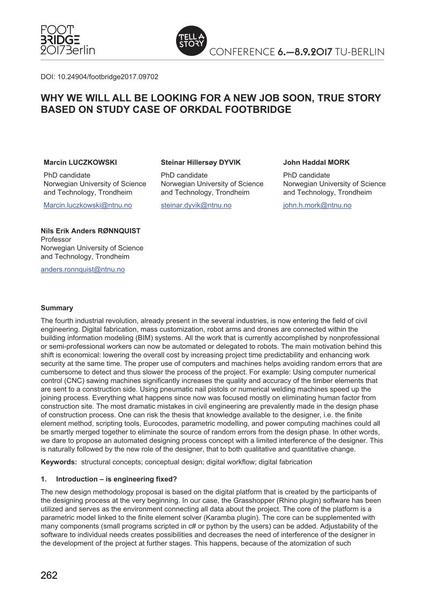Why we Will all be Looking for a new Job Soon. True Story Based on Study Case of Orkdal Footbridge

| Auteur(s): |
Marcin Luczkowski
Steinar Hillersøy Dyvik John Haddal Mork Nils Erik Anders Rønnquist |
|---|---|
| Médium: | papier de conférence |
| Langue(s): | anglais |
| Conférence: | Footbridge 2017 Berlin - Tell A Story, 6-8.9.2017, Technische Universität Berlin (TU Berlin) |
| Publié dans: | Footbridge 2017 Berlin - Tell A Story |
| Année: | 2017 |
| DOI: | 10.24904/footbridge2017.09702 |
| Abstrait: |
The fourth industrial revolution, already present in the several industries, is now entering the field of civil engineering. Digital fabrication, mass customization, robot arms and drones are connected within the building information modeling (BIM) systems. All the work that is currently accomplished by nonprofessional or semi-professional workers can now be automated or delegated to robots. The main motivation behind this shift is economical: lowering the overall cost by increasing project time predictability and enhancing work security at the same time. The proper use of computers and machines helps avoiding random errors that are cumbersome to detect and thus slower the process of the project. For example: Using computer numerical control (CNC) sawing machines significantly increases the quality and accuracy of the timber elements that are sent to a construction side. Using pneumatic nail pistols or numerical welding machines speed up the joining process. Everything what happens since now was focused mostly on eliminating human factor from construction site. The most dramatic mistakes in civil engineering are prevalently made in the design phase of construction process. One can risk the thesis that knowledge available to the designer, i.e. the finite element method, scripting tools, Eurocodes, parametric modelling, and power computing machines could all be smartly merged together to eliminate the source of random errors from the design phase. In other words, we dare to propose an automated designing process concept with a limited interference of the designer. This is naturally followed by the new role of the designer, that to both qualitative and quantitative change. |
| License: | Cette oeuvre est soumis au droits d'auteurs. Le(s) détenteur(s) des droits permet(tent) l'utilisation la visualistion et le téléchargement de cette oeuvre. La retransmission ou la publication nécessite la permission des détenteurs des droits. |
0.57 MB Télécharger le texte intégral (fichier PDF)
0.46 MB
- Informations
sur cette fiche - Reference-ID
10075343 - Publié(e) le:
01.09.2017 - Modifié(e) le:
05.06.2024



